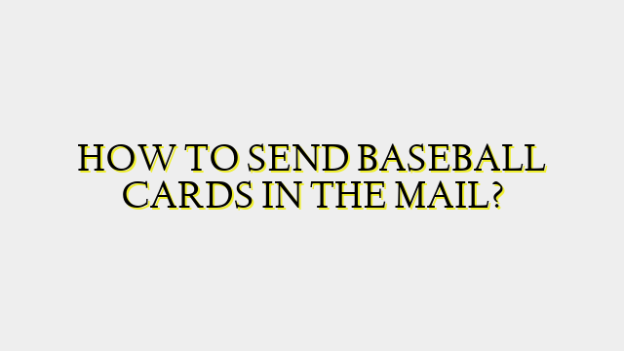Choose the right level of postage
Make sure to check the weight of the baseball cards package to determine the correct postage. You don’t want the package to be weighed and require additional postage upon receipt. Plain white envelopes tend to require less postage than larger packages. Calculate your postage accurately to avoid charges upon delivery.
Prepare the cards for mailing
Ensure all the cards are in toppler condition before putting them in the envelope or package. Check that none of the cards have folds, bends, creases or other damage that may get exacerbated during transit. It’s a good idea to store cards in top loaders, penny sleeves, or other protective holders to avoid scratches or damage during mailing. You may want to back cards with stiff cardboard or foam core to prevent bending.
Choose a rigid mailer or box for structure
Thick paper envelopes or boxes are better than regular envelopes for protecting cards during shipping. The structure prevents bending or crushing that could damage corners or edges. Consider using a penny sleeve backed 3×4 single card top loader, magnetic or screw top box, or rigid mailer designed for trading cards. Avoid overstuffing which could still cause bending.
Cushion and secure contents
Cushion the inside of your chosen mailer or box with acid free papers, tissue papers, or cardboard/bubble wrap to prevent shifting and impact during transit. Secure cards snugly but not tightly so they don’t slide around inside. Add extra padding to corners and edges that may experience more impact. Seal all openings on boxes securely with heavy duty packing or shipping tape.
Write carefully on the package
Clearly print the recipient address as well as your return address on the package exterior. Consider double checking addresses to avoid shipping to the wrong location. Add appropriate postage directly onto packaging if using stamps rather than at the post office. Write any special instructions like “Fragile” or “Do Not Bend” to alert handlers. Avoid covering address areas with extra markings or labels.
Add delivery confirmation if required
Some higher value baseball card collections may warrant the extra security of delivery confirmation or signature tracking. This provides proof of delivery and addresses liability concerns if something were to go missing. Weigh the worth of the cards against the added cost for the protection. Ordinary cards can often safely travel without extra tracking needed.
Keep mailing records and tracking info
Write down the recipient name, address, date mailed, postage used and any tracking numbers for your records in case of loss or damage. Consider taking photos of packaged items before dropping off. Some postage providers allow online package tracking too for peace of mind during transit. Having records streamlines any potential insurance claims down the road.
Choose delivery and timing wisely
Wait for weekends or days with better delivery coverage if possible rather than rushing everyday mail. Dropping off nearer to carrier pickup times rather than late in the day also ensures faster movement through the system. Don’t mail valuable items on Fridays for weekend delivery since tracking stops then. Consider professional carriers like UPS, FedEx for reliable tracking if very valuable cards need guaranteed tracking.
Address any issues immediately
Promptly contact the post office if your baseball cards don’t arrive as scheduled or show up damaged. Most carriers have specific claim windows so act quickly. Photo evidence and records simplify claims. Replacing lost or damaged items may require insurance or double checking coverage limits chosen. Avoid re-mailing valuable items without ensuring previous issues are fully addressed first to avoid repetition.
Taking care with packaging, preparation, postage research, tracking choices and prompt response to issues can help ensure safe baseball card delivery through the mail. Going the extra mile with protection and documentation pays off should any transit problems occur. Careful handling at both ends also minimizes risk of damage or loss in transit. Proper planning makes for happy baseball card collecting!




